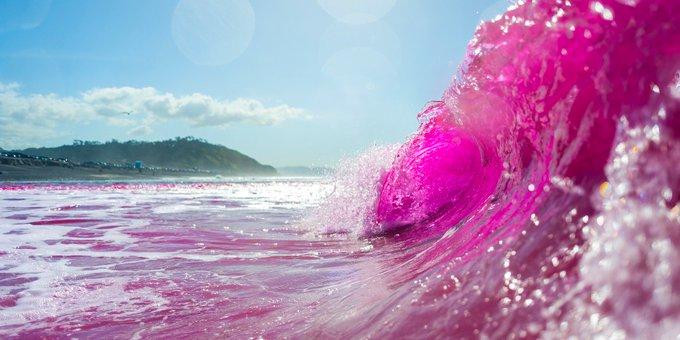In the name of scientific research, an experiment at a San Diego beach is temporarily turning the ocean pink. Plumes in Nearshore Conditions, or PiNC, is a pink-hued dye experiment led by researchers from UC San Diego’s Scripps Institution of Oceanography and the University of Washington to explore how minor freshwater outflows interact with the surf zone.
The project is focused on the estuary and surrounding coastline at Los Peasquitos Lagoon, located within Torrey Pines State Beach and Natural Reserve in San Diego, Calif. The first of three dye releases began on January 20, with the remaining releases planned for late January and early February 2023.
Rivers and estuaries play an important role in delivering freshwater and materials to the coastal ocean, but little is known about how these plumes of more buoyant, fresher water interact with the denser, saltier, and often colder nearshore ocean environment, particularly when they encounter breaking waves. The PiNC research team can track the processes that occur when small-scale plumes of freshwater reach the surf zone by releasing an environmentally friendly pink dye in the mouth of the estuary.
“I’m excited because this research hasn’t been done before and it’s a really unique experiment,” said Scripps coastal oceanographer Sarah Giddings, who is leading the PiNC study. “We’re bringing together a lot of different people with different expertise, such that I think it’s going to have some really great results and impacts.” “We will combine results from this experiment with an older field study and computer models that will allow us to make progress on understanding how these plumes spread.”
Researchers are following the bright pink dye from land, sea, and sky using a range of instruments, such as drones, sensors attached to sand poles in the river mouth and surf zone, and a jet ski equipped with a fluorometer—a device that monitors the fluorescence or light released by the dye. Several moorings and sensors put along the bottom are measuring ocean currents and other parameters such as wave heights, tides, salinity, and temperature.
The PiNC experiment, according to the researchers, will provide the first-ever view of the buoyant plume/wave mixing dynamics at work in this specific location, leading to a better understanding of how other small-to-moderate outflows of freshwater interact with the waves at locations around the world. This study’s findings will be critical in assessing the spread of silt, contaminants, larvae, and other essential items in the nearshore environment.
This isn’t the first-time science has been tickled pink. A 2015 experiment by Scripps Oceanography scientists was used to track beach pollution dynamics near the U.S.-Mexican border with pink dye. The experiment is set to run through February with two more dye releases.

